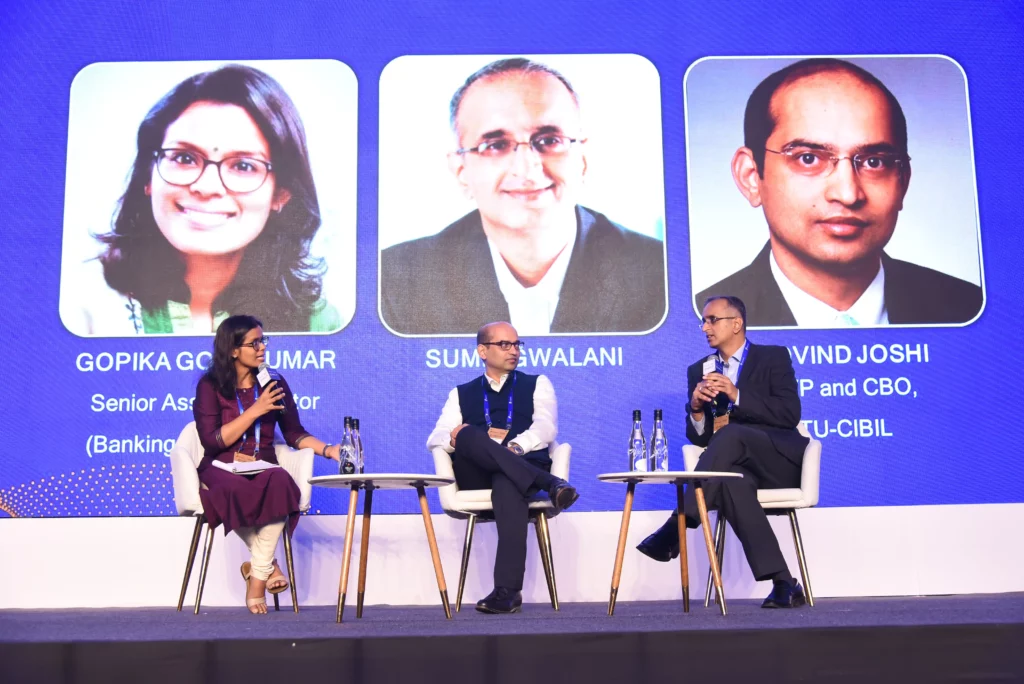Digital Data. How to make it work for India?
Users need to engage with the data actively to determine if it works. Simply collecting data is not enough; its effectiveness can only be gauged when users use it. Ultimately, data comes alive and serves its purpose when users actively engage with it, helping us understand its practical significance. For AA, which is touted to be the next UPI, it is essential to be popular among all of us. Read further for insightful comments on the future trajectory of the Account Aggregator (AA) ecosystem as Sumit Gwalani, Co-founder Epifi Wealth, and Govind Joshi, EVP, and CBO TU-CIBIL, engage in a thought-provoking discussion with Gopika Gopakumar of Mint in this SamvAAd event.

How can AAs become Popular?
It is essential to understand that AAs are still in their early stages. As additional FIUs & data types and FIUs & TSPs join the ecosystem, more use cases will emerge, ranging from credit and wealth management to PFM and rural finance. This combinatorial innovation from within the ecosystem can impact financial inclusion across the country, improving the daily lives of individuals.
AAs have simplified complex processes requiring meticulous Excel sheets to manage finances accessible and user-friendly. The customer/user numbers will grow exponentially as more entities join the ecosystem as FIUs provide innovative use cases. The increasing participation of financial institutions and the expansion of services will contribute to the widespread adoption of AA, a more extensive user base, and enhanced customer experiences.
How does TU-CIBIL leverage data from AA?
AAs substantially increase data flows through the system– not only traditional credit histories but also timely credit card payments, mortgage information, and other factors contributing to assessing the ability and intent to pay. From a credit bureau perspective, AA significantly enhances the country’s financial inclusion efforts. The introduction of AA technology brings about transformative changes, enabling evaluating a broader range of data points. TUCIBIL is actively embracing these changes and working towards leveraging AA to enhance credit decision-making and support the growth and development of MSMEs.
Prospective Innovations?
Sumit shed light on the vast possibilities AAs enable. Take a look at a few of them below:
- By leveraging bank statements, AAs can help users check refunds, monitor for fraud, and identify double payments.
- AAs can offer personalized wealth management advice by incorporating data from mutual funds, equities, and bank statements from multiple banks.
- Insurance plans can be customized to meet customer needs better.
- AAs can catapult financial inclusion efforts through innovative credit solutions.
Overall, the account aggregator ecosystem represents the next financial revolution in India. The responsibility lies with the account aggregators to create value and meaningful impact for the end-users, paving the way for a transformative shift in the financial landscape.
Control Measures for Responsible Data Use?
Sumit opined that AAs have intrinsically incorporated control measures for responsible data use, such as:
- One key aspect is the user consent revocability for data access, regardless of the expiry time set for data usage. This empowers users with complete control over their data, allowing them to withdraw consent if necessary.
- Users have the right to request the erasure or deletion of their data unless specific laws mandate the storage of such data. This ensures individuals can manage and protect their personal information, reinforcing responsible data practices.
By incorporating these measures, the framework promotes responsible data use and supports users’ trust and confidence in the system.
How to be the next UPI?
Govind remarked that the account aggregator ecosystem has immense potential for growth in two key dimensions– specific niche use caseslocalized solutions and cross-sectoral data use cases. The ecosystem can gain traction and attract more users by identifying and addressing specific needs within niche markets. Similarly, abundant information within cross-sectoral, large-scale datasets opens opportunities for innovative use cases and insights.
All financial sector regulators have collaborated to take a structured approach toward the goal of open finance. Over the past year, there has been a remarkable increase in the usage and adoption of AAs. With the current trajectory, there is ample reason to believe that the account aggregator ecosystem can achieve even greater heights, potentially entering UPI-like growth territory.
How do you make Data Popular?
Expanding AAs usage beyond specific lending and insurance use cases is crucial to make data popular. The true potential of AAs lies in their integration into daily and weekly routines, similar to the widespread adoption of UPI. Additionally, AAs can streamline identity verification processes, automating traditionally cumbersome procedures to solve real-life everyday problems.
Customer-centric Smooth Experience
Not all processes can become instant, as it depends on the nature of the problem being addressed and the level of risk individuals are willing to undertake. The problem UPI addresses differs from what AA is solving, and the breadth of the solutions provided by AA is significantly wider. However, the speed of instant transactions may vary depending on the specific use cases and associated risks. Nevertheless, the aim is to make financial transactions more seamless and frictionless through the AA ecosystem. Success rates may start low, and it will take time for more financial institutions to come on board. However, over the next two to three years, we can expect to see similar growth as witnessed with UPI.
For the complete conversation, check out this YouTube video:
Does the comparison between UPI and AA fascinate you? Check out the “Open Payments to Open Data: Is There a Playbook?” blog for a deep-dive into the foundational principles of scaling population-scale digital infrastructure: Open Payments to Open Data: Is There a Playbook? – Sahamati
Related Readings
